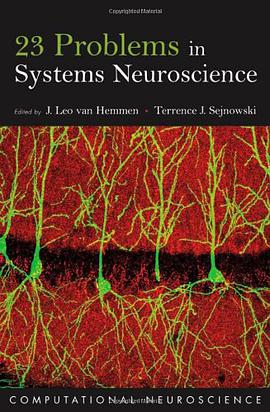23 Problems in Systems Neuroscience
豆瓣
Van Hemmen, Leo J. / Sejnowski, Terrence J.
简介
The complexity of the brain and the protean nature of behavior remain the most elusive area of science, but also the most important. van Hemmen and Sejnowski invited 23 experts from the many areas--from evolution to qualia--of systems neuroscience to formulate one problem each. Although each chapter was written independently and can be read separately, together they provide a useful roadmap to the field of systems neuroscience and will serve as a source of inspirations for future explorers of the brain.
contents
Part I: How have brains evolved?
1: Gilles Laurent: Shall we ever understand the fly's brain?
2: Hermann Wagner and Bernhard Gaese: Can we understand the action of brain in natural environments?
3: Gunther Ehret: Hemisphere dominance of brain function-which functions are lateralized and why?
Part II: How is the cerebral cortex organized?
4: S. Murray Sherman: What is the function of the thalamus?
5: J. Leo van Hemmen: What is a neuronal map, how does it arise, and what is it good for?
6: Jean Bullier: What is fed back?
Part III: How do neurons interact?
7: Wulfram Gerstner: How Can the Brain be so Fast?
8: C. van Vreeswijk: What is the Neural Code?
9: Tal Kenet, Amos Arieli, Misha Tsodyks and Amiram Grinvald: Are single cortical neurons independent or are they obedient members of a huge orchestra?
10: Bruno A. Olshausen and David J. Field: What is the other 85% of V1 doing?
Part IV: What can brains compute?
11: Steven W. Zuck: Which computation runs in visual cortical columns?
12: C.E. Carr, S. Iyer, D. Soares, S. Kalluri and J.Z. Simon: Are neurons adapted for specific computations? Examples from temporal coding in the auditory system
13: Andreas V.M. Herz: How is time represented in the brain?
14: David McAlpine and Alan R. Palmer: How general are neural codes in sensory systems?
15: Georg M. Klump: How does the hearing system perform auditory scene analysis?
16: Laurenz Wiskott: How does our visual system achieve shift and size invariance?
Part V:
17: Henning Scheich, Frank W. Ohl, Holger Schulze, Andreas Hess, and André Brechmann: What is reflected in sensory neocortical activity: External stimuli or what the cortex does with them?
18: Giacomo Rizzolatti and Vittorio Gallese: Do perception and action result from different brain circuits? The three visual systems hypothesis
19: Terrence J. Sejnowski: What are the projective fields of cortical neurons?
20: John H. Reynolds: How are the features of objects integrated into perceptual wholes that are selected by attention?
21: L. F. Abbott: Where are the switches on this thing?
22: V.S. Ramachandran and Edward M. Hubbard: Synesthesia: What does it tell us about the emergence of qualia, metaphor, abstract thought and language?
23: Francis Crick and Christof Koch: What are the neural correlates of consciousness?